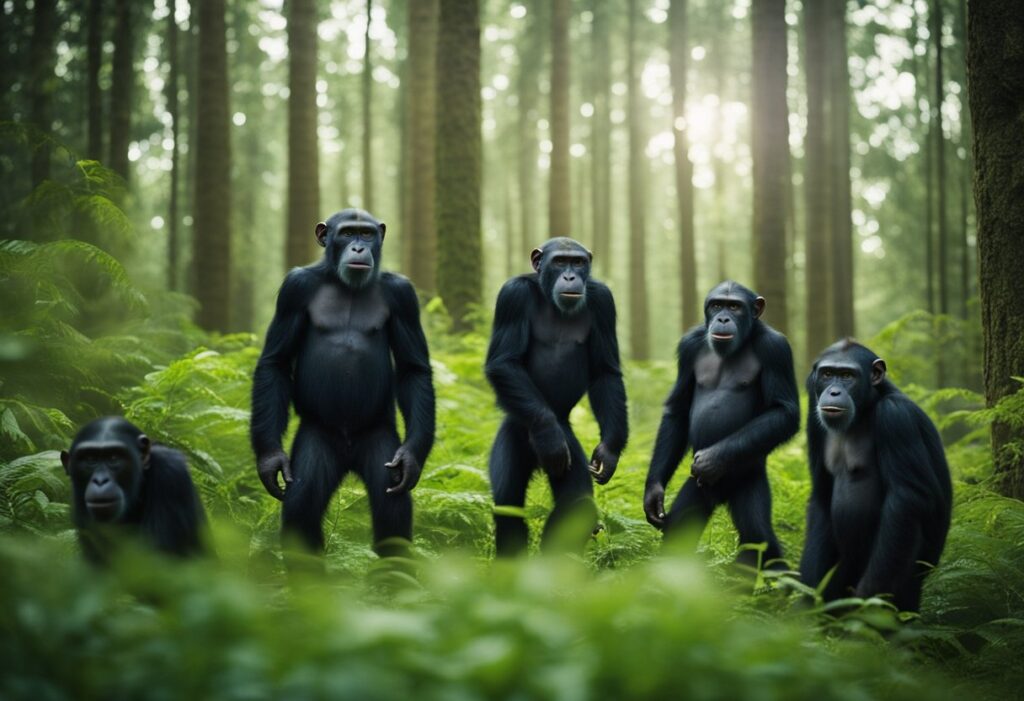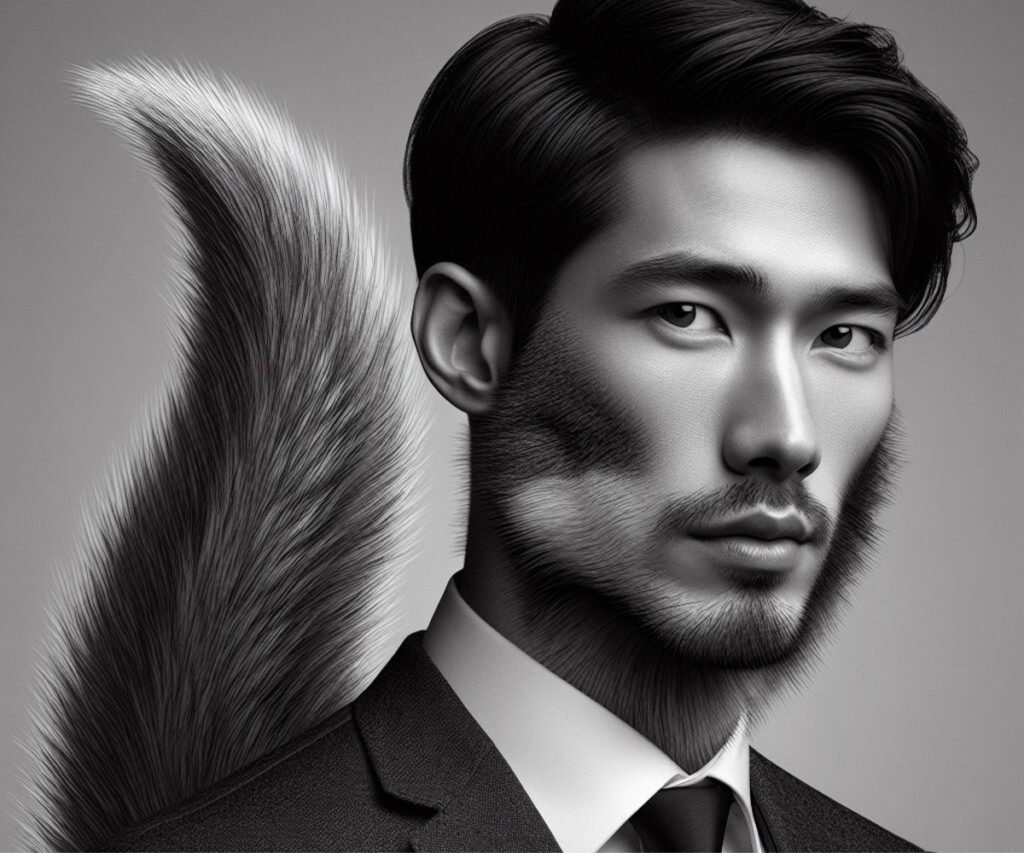
Let’s say it immediately – if humans had tails, our lives would be drastically different.
From an evolutionary perspective, tails were present in our primate ancestors and served a variety of functions, such as aiding in balance, communication, and grasping. However, over time (roughly 25 million years ago), primates lost their tails.
Nonetheless, despite the absence of tails in modern humans, some people are born with a vestigial tail, a structure consisting of a few vertebrae and some muscle tissue at the base of the spine. These tails do not serve any functional purpose, and they are almost always surgically removed.
Interesting fact: Boys are twice as likely to be born with a tail!
Yet, it is interesting to wonder – What if humans had tails?
Namely, if humans had tails, there would be many anatomical implications to consider, such as changes in posture, gait, and balance. Additionally, there would be physiological functions to explore, such as the potential benefits to spinal health and the impact on reproductive systems.
Furthermore, cultural and societal changes would occur, such as changes in furniture design and toileting habits.
And so, let’s explore this hypothesis and thought experiment in more detail, starting with a bit of history.
Related:
Evolutionary Perspective

Primate Ancestry and Tails
Looking at human evolution, our distant primate ancestors had some sort of tail. According to bioRxiv study, the loss of the tail is one of the main anatomical evolutionary changes that occurred along the lineage leading to humans and to the “anthropomorphous apes”.
This morphological reprogramming in the ancestral hominoids has been long considered to have accommodated a characteristic style of locomotion and contributed to the evolution of bipedalism in humans.
Reasons for Human Tail Loss
The precise genetic mechanism that facilitated tail-loss evolution in hominoids remains unknown. However, the study bioRxiv presents evidence that tail-loss evolution was mediated by the insertion of an individual Alu element into the genome of the hominoid ancestor.
They demonstrate that this Alu element pairs with a neighboring ancestral Alu element encoded in the reverse genomic orientation and leads to a hominoid-specific alternative splicing event. This event is responsible for the loss of the tail in humans.
And so, after delving into a bit of history and evolution, let’s return to modern times and see if there are any humans today with a tail.
Humans Today Born with Vestigial Tail

While very rare, some humans are born with vestigial tails. These tails are small, non-functional protrusions at the base of the spine, typically measuring only a few centimeters in length. According to a NCBI research, there are only 40 cases of true human tails reported in the literature.
The cause of vestigial tails in humans is not fully understood, but it is believed to be related to a genetic mutation that affects the development of the tailbone during fetal development.
In some cases, the vestigial tail is made up of fatty tissue and skin, while in others it may contain cartilage, muscles, and even nerves.
It is important to note that vestigial tails are not the same as true tails, which are functional appendages found in many animals. True tails are used for balance, communication, and other purposes, and are typically much longer and more complex than vestigial tails.
And so, with that, let’s explore this thought experiment: What would happen if humans really had tails?
Anatomical Implications

If humans had tails, it would have significant anatomical implications. Here are some of the ways in which the human anatomy would be affected:
Spinal Modifications
One of the primary benefits of having a tail would be the reduced strain on the spine. The tail would act as a counterbalance, distributing the weight of the body more evenly. This would reduce the pressure on the lower back, which is a common cause of pain and discomfort in humans.
However, the tail would also require additional support from the spinal column, which would need to be modified to accommodate the extra structure. This would likely result in changes to the curvature of the spine and the position of the pelvis.
Okay, and what about physiological functions?
Let’s explore more.
Physiological Functions

If humans had tails, they would probably serve several important physiological functions.
Here are two of them:
Balance and Agility
One of the primary functions of tails in animals is to help with balance and agility. For example, cats use their tails to maintain balance when jumping or running. Similarly, monkeys and other primates use their tails to help them move through trees and other environments.
If humans had tails, they could potentially use them in similar ways. A tail could help with balance during activities like running, jumping, or climbing. It could also provide additional support when walking on narrow surfaces or uneven terrain.
Non-Verbal Communication
Another important function of tails in animals is non-verbal communication. Many animals use their tails to communicate a wide range of emotions, from fear and aggression to happiness and excitement.
If humans had tails, they could potentially use them to communicate non-verbally as well. For example, a person could wag their tail to show happiness or excitement, or tuck it between their legs to indicate fear or submission.
Moreover, a society in which humans have tails would be vastly different from today’s ‘tailless’ society.
Cultural and Societal Changes

Fashion and Design
If humans had tails, it would undoubtedly change the fashion and design industry. Clothing would have to be designed to accommodate the tail, and it would have a significant impact on the way people dressed.
For example, pants would have to be redesigned to have a hole for the tail or be made of stretchy material to allow for movement. Dresses and skirts would also have to be adjusted to allow for the tail to move freely.
In addition to clothing, accessories such as belts, bags, and backpacks would have to be redesigned to accommodate the tail. Belts would have to be adjustable to fit around the waist and tail, and backpacks would have to have a hole for the tail to fit through.
Social Norms and Stigmas
The addition of a tail to humans would bring about new social norms and stigmas. For example, people with longer or thicker tails might be seen as more attractive or powerful, while those with shorter or thinner tails might be seen as less attractive or weaker.
There might also be social norms around how much the tail is shown or hidden. In some cultures, the tail might be seen as a symbol of status or wealth, while in others, it might be seen as a source of shame or embarrassment.
Moreover, in the ‘tail world,’ our living environment would need to be entirely different.
Changes in Furniture

If humans had tails, furniture design would have to change to accommodate them. Chairs, for example, would need to have a gap in the backrest to allow the tail to hang freely. A chair with a solid backrest would be uncomfortable for a person with a tail, as it would cause pressure on the tailbone.
Beds would also have to be modified to accommodate tails. A person with a tail would not be able to sleep comfortably on their back, so a bed with a hole would be necessary.
In addition to chairs and beds, doors would also probably need to be redesigned.
Overall, if humans had tails, furniture and living rooms would have to change to accommodate them. It would be interesting to see how different chairs, beds, and doors would look in a world where humans have tails.
However, in ‘tail world,’ we’d probably witness the biggest changes in our bathrooms and toilets.
Toilet Changes

If humans had tails, it would significantly affect their bathroom habits.
For instance, toilets would need to be completely modified to accommodate tails. People would need to install toilets with larger and wider seats to accommodate their tails comfortably.
Moreover, humans with tails would require a different approach to wiping themselves after using the toilet. People would need to use wet wipes or bidets to clean themselves thoroughly without touching their tails.
In addition to these practical considerations, humans with tails would also need to adjust their bathroom etiquette. They would need to learn how to position themselves on the toilet to avoid hitting their tails on the walls or other objects in the bathroom.
People would also need to learn how to take care of their tails, such as washing them regularly to prevent infections and other health problems.
Overall, if we had tails, this would require significant changes to our bathroom habits and etiquette.
And this leads us to final part – tails, technology and workplaces.
Technological and Occupational Impact

Workplace Adaptations
If humans had tails, workplaces would need to be adapted to accommodate the new appendage. Chairs would need to be designed with tail support to prevent discomfort or injury, and desks would need to be adjusted to allow for comfortable seating.
Additionally, tail-friendly uniforms would need to be created for workers in industries such as construction, where safety gear is mandatory.
Innovations in Technology
The addition of tails to humans would also lead to innovations in technology. For example, prosthetic tails could be developed for individuals who are born without tails or who have lost them due to injury. These prosthetics would need to be designed to mimic the function of a natural tail, allowing for balance and agility.
Furthermore, technology could be developed to enhance the abilities of a natural tail. For example, sensors could be implanted in the tail to allow for greater control and precision of movement. This could be particularly useful in industries such as manufacturing, where precision and accuracy are essential.
Conclusion

In conclusion, if humans had tails, it would undoubtedly impact various aspects of our daily lives and social dynamics. Firstly, the addition of tails could offer an extra dimension of balance, agility, and coordination, potentially influencing our physical activities and sports. Additionally, the tail might serve as a non-verbal communication tool, conveying emotions and intentions, leading to a more nuanced understanding among individuals.
The presence of tails would also bring changes in fashion trends and design, as clothing would need to accommodate this appendage. Social norms and etiquette would evolve to include tail-related gestures or expressions, shaping a unique cultural landscape. Furthermore, the tail would probably be a symbol of individuality and personal expression, adding a distinctive element to human identity.
In the end, this thought experiment of humans having tails is rather interesting and fun. This slight change in our human body would alter almost everything compared to the world we’re living in currently.
Frequently Asked Questions

What are the three types of tails?
If humans had tails, they could be classified into three types: prehensile, non-prehensile, and vestigial. Prehensile tails are flexible and capable of grasping objects, while non-prehensile tails are stiff and used mainly for balance. Vestigial tails are underdeveloped and have no function.
What are the potential evolutionary advantages or disadvantages of humans having tails?
The potential evolutionary advantages of humans having tails include improved balance, increased mobility, and the ability to use the tail as a tool. Disadvantages could include the risk of injury, the need for additional energy to support the tail, and the potential for the tail to become a target for predators.
In what ways would human clothing and fashion change to accommodate tails?
If humans had tails, clothing and fashion would need to be adapted to accommodate them. Clothing would need to be designed with tail holes or slits, and tail accessories could become popular. Tail grooming and styling could also become a trend.
How might human body language and communication be altered if we had tails?
If humans had tails, body language and communication would be altered significantly. Tails could be used to express emotions, convey information, and establish social hierarchies. Tails could also be used to signal aggression or submission.
What kind of societal and cultural impacts could result from humans developing tails?
The development of tails could have significant societal and cultural impacts. Tails could become a symbol of status or beauty, and tail-related traditions and customs could develop. Tails could also be the subject of discrimination or prejudice.
Could tails have any practical functionality for humans in a modern context?
If humans had tails, they could potentially have practical functionality in a modern context. Tails could be used for balance in sports or physical activities, and they could also be used as a tool for carrying objects or manipulating tools. However, the practicality of tails would depend on their size, strength, and flexibility.




















